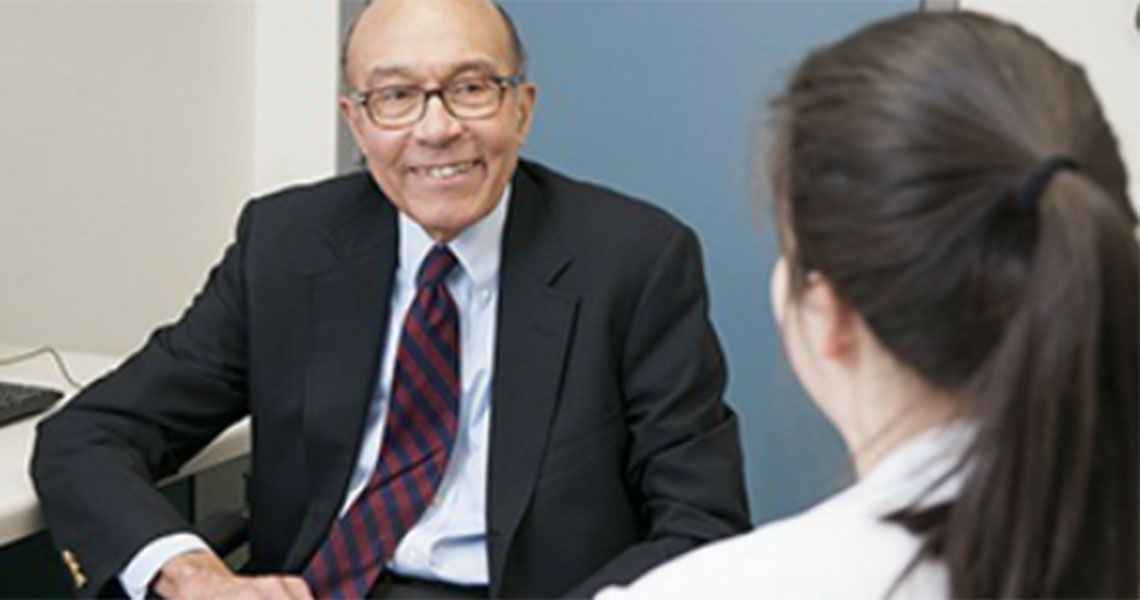Samantha Ahle felt that her percussing, a method of diagnosis used in clinical examinations, needed some improvement. “I was an awful percussor,” said Ahle, a third-year medical student at The George Washington University School of Medicine and Health Sciences (SMHS). “It’s one of those things that we all learned how to do and everyone does it all the time, but no one actually watches you to make sure you’re doing it right. And technique matters,” she said. “Having someone guide you through it – someone who knows exactly how it’s supposed to be done – is very beneficial.”
Thanks to the Observed History and Physical Examination, a hallmark of the internal medicine rotation for third-year students at SMHS since the early 1990s, Ahle had the opportunity to work one-on-one with a retired GW faculty member who helped her improve her percussing technique, as well as other aspects of performing a physical exam and complete history-taking. “I’m absolutely confident that I’m better at it now,” Ahle said of her percussing.
The group of retired faculty members who serve as preceptors for this invaluable program is led by Stanley Talpers, M.D., associate professor emeritus of clinical medicine and health care sciences, who is also the program’s founder. It includes David Goodman, M.D., Albert Grollman, M.D., Richard Kaufman, M.D., Gordon Mella, M.D., Harold Sadin, M.D., and Robert Wilkinson, M.D., MACP, professor emeritus of clinical medicine. Richard Nicklas, M.D., current clinical professor of medicine, also serves as a preceptor.
Juan Reyes, M.D. ’04, M.P.H. ’00, assistant professor of medicine at SMHS, has served as clerkship director in internal medicine since 2012. He is moved by the generosity of the retired faculty members who volunteer their time to spend at least two hours with each medical student to observe the physical examination and history-taking of a patient during the two-month rotation.
Reyes attributes the preceptors’ compassion to the pride they have in GW. “They are masters at what they do,” Reyes said. “They take their time to teach some skills that have gotten lost along the way, and they find such joy to think that they have made a difference in someone. They are contributing to the education of each and every student,” he said.
Alan Wasserman, M.D., M.A.C.P., Eugene Meyer Professor of Medicine and chair, Department of Medicine at SMHS, and president of the GW Medical Faculty Associates, echoes Reyes’ praise of the program. “It’s almost overwhelmingly looked at as one of the best things that students get to do in their third year of medical school because it’s such a unique experience,” Wasserman said. He considers physical diagnosis to be a dying art, and stresses the importance of the “pearls of wisdom” shared by the retired physicians that students can’t get from anywhere else.”
Wasserman notes that present-day reliance on complicated tests and machines, which have rendered the physical diagnosis less crucial, is not sustainable. “It’s very expensive,” he said. “In the day of the Affordable Care Act, I think we’ll be going back to relying on some of our diagnostic skills and thinking twice about how many tests we order.”
Ahle also sees the benefit of learning physical techniques that are not in wide use in the United States today. “Who knows where we’re going to go and where any of us will end up practicing,” she said. “There are still lots of people in the world that don’t have all of these advantages, so it’s good to know about.”
Reyes encourages students to stay relaxed in order to get the most out of the observed history and physical examination, which is why the experience is not graded. And it is evident from the glowing evaluations at the end of each rotation that it’s working. “That’s what’s amazing,” Reyes said. “It might have taken these physicians decades to discover a certain golden nugget, and that can be imparted to the student in a single two-hour session.”



